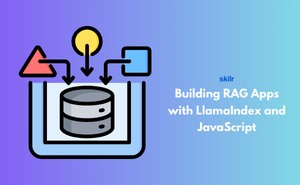👇 CELEBRATE CLOUD SECURITY DAY 👇
00
HOURS
00
MINUTES
00
SECONDS

Developing RAG Applications with LlamaIndex and JavaScript involves designing intelligent tools that can combine AI-generated responses with real-time data retrieval. By using the RAG approach, the app first searches for relevant documents or knowledge, then leverages AI to generate precise, context-rich answers. LlamaIndex helps simplify this connection between external data and large language models, while JavaScript ensures the app can run smoothly on the web.
Put simply, this training shows how to create next-generation apps where AI acts smarter by accessing extra information when needed. Instead of giving generic answers, the app delivers reliable and detailed responses that are both dynamic and user-friendly.
This exam is ideal for:
Domain 1 - Introduction to RAG
Domain 2 - Getting Started with LlamaIndex
Domain 3 - JavaScript Essentials for RAG Apps
Domain 4 - Data Sources and Integration
Domain 5 - Building RAG Apps with LlamaIndex + JavaScript
Domain 6 - Enhancing Applications
Domain 7 - Deployment and Scaling
Domain 8 - Real-World Use Cases
Industry-endorsed certificates to strengthen your career profile.
Start learning immediately with digital materials, no delays.
Practice until you’re fully confident, at no additional charge.
Study anytime, anywhere, on laptop, tablet, or smartphone.
Courses and practice exams developed by qualified professionals.
Support available round the clock whenever you need help.
Easy-to-follow content with practice exams and assessments.
Join a global community of professionals advancing their skills.
As the demand for AI-powered applications continues to rise, developers skilled in building RAG apps with LlamaIndex and JavaScript will have a competitive edge in the job market. Gaining expertise in these areas opens opportunities in emerging fields such as AI development, machine learning engineering, and full-stack development, all of which are critical for advancing a tech-focused career.
LlamaIndex provides a streamlined approach to integrating large language models with external data sources. Its ease of use, scalability, and comprehensive query management system make it an ideal choice for developers building RAG apps. It also supports multiple data formats, which increases its flexibility in handling various types of data, such as documents, databases, and APIs.
LlamaIndex simplifies the process of integrating external data with large language models by providing easy-to-use tools for data ingestion, indexing, and querying. It allows developers to build efficient RAG systems that can manage multiple data sources and provide accurate, domain-specific responses to user queries.
JavaScript is essential for handling the backend logic of RAG applications. It enables the integration of LlamaIndex with external APIs and data sources, handles querying and data retrieval processes, and facilitates the interaction between the language model and the user-facing application. JavaScript's versatility makes it ideal for building both server-side and client-side components of RAG applications.
RAG apps enable businesses to enhance their customer support systems, provide more personalized services, and create more responsive AI-driven applications. By integrating real-time, domain-specific data into the model's responses, businesses can provide more accurate and contextually relevant answers to users, improving user experience and satisfaction.
This course is suitable for software developers, data scientists, and machine learning engineers interested in developing advanced AI-driven applications. It is particularly beneficial for those eager to explore the intersection of large language models, data retrieval, and JavaScript-based application development.
Developers skilled in building RAG apps with LlamaIndex and JavaScript are in demand in industries such as AI development, software engineering, data science, and cloud computing. Job roles include AI/ML Engineer, Backend Developer, Full-stack Developer, and Data Engineer, particularly in organizations leveraging natural language processing for customer service, chatbot applications, and enterprise-level data systems.
The growing demand for AI-driven customer service, chatbots, and intelligent assistants has led to an increase in the need for RAG applications. Companies are seeking ways to combine LLMs with external data sources to provide real-time, contextually accurate responses. This trend is pushing the demand for developers who can integrate advanced data retrieval and processing systems with language models.
To build RAG apps, you need proficiency in JavaScript, particularly for backend logic and API integrations. Additionally, a solid understanding of LlamaIndex for data ingestion, indexing, and query handling is crucial. Familiarity with natural language processing (NLP) concepts, databases, and API consumption is also important for integrating external data sources.
A Retrieval-Augmented Generation (RAG) app combines the power of language models with external data retrieval to generate more accurate, context-aware responses. This approach allows the model to fetch data from databases, APIs, or other data sources before generating output, making it ideal for applications that require real-time, up-to-date, or domain-specific information.